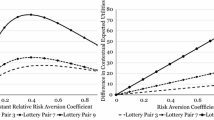Abstract
We conduct a battery of experiments in which agents make choices from several pairs of all-loss-lotteries. Using these choices, we estimate a representation of individual preferences over lotteries. We find statistically and economically significant departures from expected utility maximization for many subjects. We also estimate a preference representation based on summary statistics for behavior in the population of subjects, and again find departures from expected utility maximization. Our results suggest that public policies based on an expected utility approach could significantly underestimate preferences and willingness to pay for risk reduction.
Similar content being viewed by others
References
Allais, Maurice. (1953). “Le Comportement de l’homme Rationnel Devant le Risque: Critique des Postulats et Axiomes de l’École Américaine,” Econometrica, 21, 503–546.
Baron, Jonathon. (1992). Thinking and Deciding. New York: Cambridge University Press.
Camerer, Colin. (1989). “An Experimental Test of Several Generalized Utility Theories,” Journal of Risk and Uncertainty 2, 61–104.
Camerer, Colin. (1995). “Individual Decision Making.” In John Kagel and Alvin Roth (eds.), Handbook of Experimental Economics. Princeton: Princeton University Press.
Camerer, Colin and Teck-H. Ho. (1994). “Violations of the Betweenness Axiom and Non-linearity in Probability,” Journal of Risk and Uncertainty 8, 167–196.
Chew, Soo Hong, Larry Epstein and Uzi Segal. (1991). “Mixture Symmetry and Quadratic Utility,” Econometrica 59, 139–163.
Chichilnisky, Graciela and Geoffrey Heal. (1993). “Global Environmental Risks,” Journal of Economic Perspectives 7, 65–86.
Fomby, Thomas, Carter Hill, and Stanley Johnson. (1988). Advanced Econometric Methods. New York: Springer-Verlag.
Freeman, A. Myrick III. (1991). “Indirect Methods for Valuing Changes in Environmental Risks with Nonexpected Utility Preferences,” Journal of Risk and Uncertainty4, 153–165.
Freeman, A. Myrick III. (1993). The Measurement of Environmental and Resource Values: Theory and Methods Washington, DC: Resources for the Future.
Harless, David. (1992). “Predictions about Indifference Curves inside the Unit Triangle: A Test of Variants of Expected Utility Theory,” Journal of Economic Behavior and Organization 18, 391–414.
Harless, David and Colin Camerer. (1994). “The Predictive Utility of Generalized Expected Utility Theories,” Econometrica 62, 1251–1289.
Hirschleifer, Jack and John G. Riley. (1992). The Analytics of Uncertainty and Information. Cambridge: Cambridge University Press.
Hey, John. (1995). “Experimental Investigations of Errors in Decision Making under Risk,” European Economic Review 39, 633–640.
Hey, John and Enrica Carbone. (1995). “Stochastic Choice with Deterministic Preferences: An Experimental Investigation,” Economics Letters 47, 161–167.
Hey, John and Chris Orme. (1994). “Investigating Generalizations of Expected Utility Theory Using Experimental Data,” Econometrica 62, 1291–1326.
Kahneman, Daniel, Jack Knetsch, and Richard Thaler. (1990). “Experimental Tests of the Endowment Effect and the Coase Theorem,” Journal of Political Economy 98, 1325–1348.
Kunreuther, Howard and Martin Pauly. (2004). “Neglecting Disaster: Why Don’t People Insure Against Large Losses?,” Journal of Risk and Uncertainty 28, 5–21.
Lichtenstein, Sarah, Paul Slovic, Baruch Fischhoff, Mark Layman, and Barbara Combs. (1978). “The Judged Frequency of Lethal Events,” Journal of Experimental Psychology 4, 551–578.
Loomes, Graham, Peter G. Moffat, and Robert Sugden. (2002). “A Microeconometric Test of Alternative Stochastic Theories of Risky Choice,” Journal of Risk and Uncertainty 24, 327–346.
Machina, Mark. (1982). “‘Expected Utility’ Analysis without the Independence Axiom,” Econometrica 50, 277–323.
Machina, Mark. (1987). “Choice Under Uncertainty: Problems Resolved and Unresolved,” Journal of Economic Perspectives 1, 121–54.
Marschak, Jacob. (1950). “Rational Behavior, Uncertain Prospects, and Measurable Utility,” Econometrica 18, 111–141.
McFadden, Daniel and Kenneth Train. (2000). Mixed MNL Models for Discrete Response. Journal of Applied Econometrics15: 447–470.
Neilson, William and Jill Stowe. (2002). A Further Examination of Cumulative Prospect Theory Parameterizations. Journal of Risk and Uncertainty 24, 31–46.
Revelt, David and Kenneth Train. (1998). “Mixed Logit with Repeated Choices: Households’ Choices of Appliance Efficiency Level,” Review of Economics and Statistics 53, 647–657.
Shogren, Jason F. and Thomas D. Crocker. (1991). “Risk, Self-protection, and Ex Ante Economic Valuation,” Journal of Environmental Economics and Management 21, 1–15.
Shogren, Jason F. and Thomas D. Crocker. (1999). “Risk and its Consequences,” Journal of Environmental Economics and Management 21, 44–51.
Starmer, Chris. (2000). “Developments in Non-Expected Utility Theory: The Hunt for a Descriptive Theory of Choice under Risk,” Journal of Economic Literature 38, 332–382.
Thaler, Richard. (1992). The Winner’s Curse. New York: Free Press.
Train, Kenneth. (1998). “Recreation Demand Models with Taste Differences over People,” Land Economics 74, 230–239.
Train, Kenneth. (1999). “Mixed Logit Models of Recreation Demand.” In Catherine Kling and Joseph Herriges (eds.), Valuing the Environment Using Recreation Demand Models. London: Edward Elgar Press.
Tversky, Amos and Daniel Kahneman. (1981). “The Framing of Decisions and the Psychology of Choice,” Science 211, 453–458.
Viscusi, W. Kip, Wesley A. Magat and J. Huber. (1991). “Pricing Environmental Health Risks: Assessment of Risk-Risk and Risk- Dollar Tradeoffs for Chronic Bronchitis,” Journal of Environmental Economics and Management21, 32–51.
Viscusi, W. Kip. (1992). Fatal Tradeoffs. New York: Oxford University Press.
Author information
Authors and Affiliations
Corresponding author
Additional information
JEL Classification: C91, D81
Rights and permissions
About this article
Cite this article
Mason, C.F., Shogren, J.F., Settle, C. et al. Investigating Risky Choices Over Losses Using Experimental Data. J Risk Uncertainty 31, 187–215 (2005). https://doi.org/10.1007/s11166-005-3554-7
Issue Date:
DOI: https://doi.org/10.1007/s11166-005-3554-7




